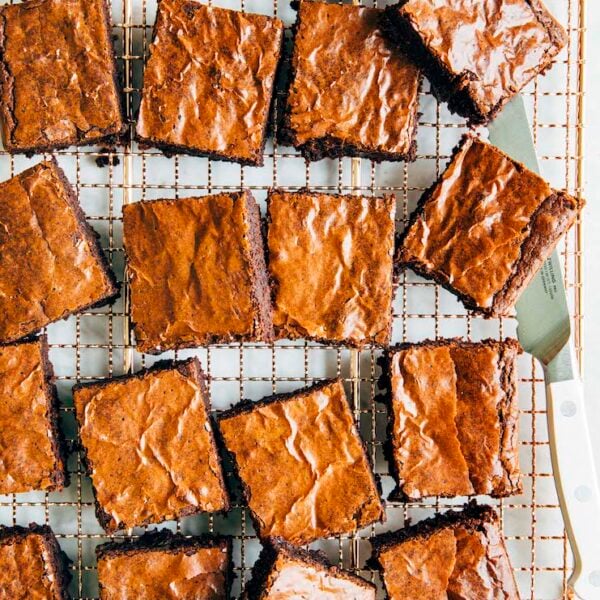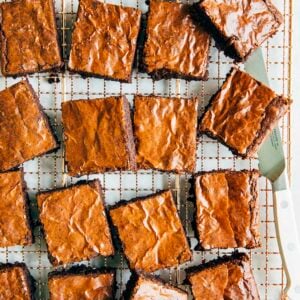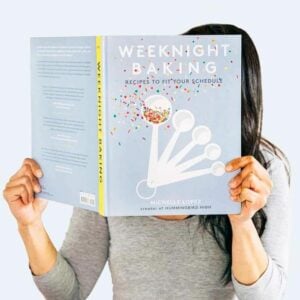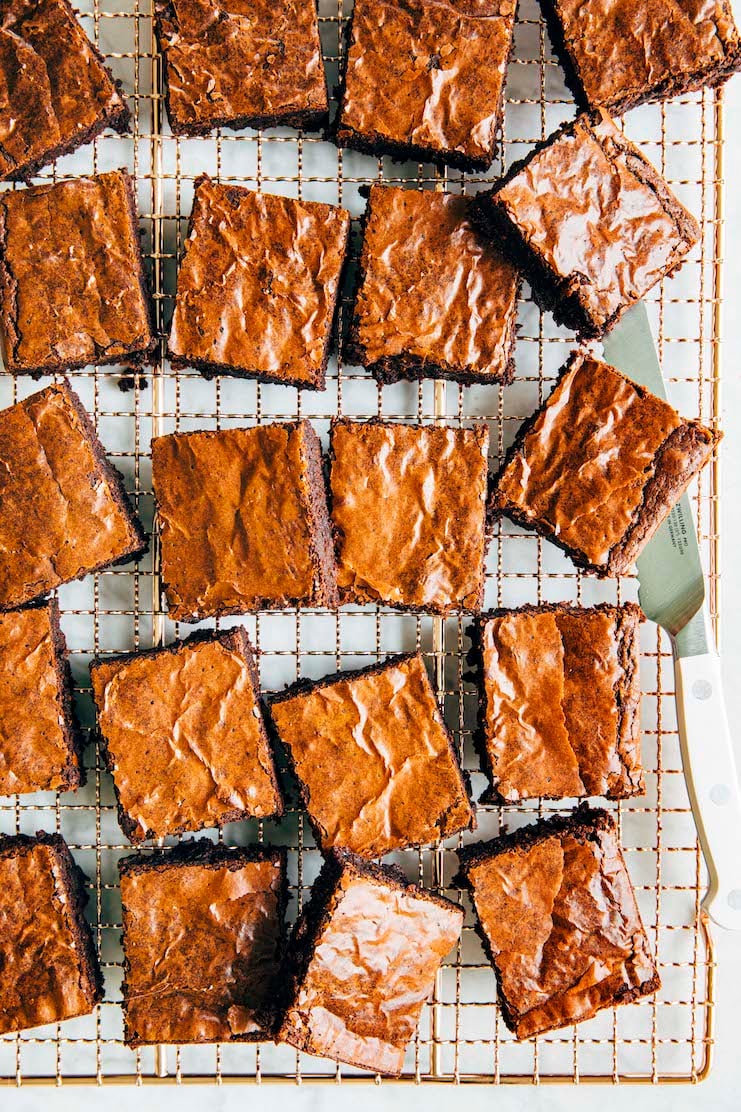
About Sarah Kieffer’s Brownies
Sarah Kieffer’s brownies are light-yet-chocolaty, fudgy-yet-chewy, and complete with a shiny top that crinkles and flakes when sliced! The recipe comes together quickly, with a batter that is mixed by hand. This is the perfect brownie recipe for folks who love boxed mix brownies, and want something a little lighter and less intense than a dense and thick homemade fudge brownie recipe!
Wait, who is Sarah Kieffer?
Sarah Kieffer is the baking blogger behind The Vanilla Bean Blog and author of multiple baking cookbooks like The Vanilla Bean Baking Book, 100 Cookies, and Baking for the Holidays. Personally, she’s one of my favorite food bloggers. I trust all her recipes wholeheartedly and rely on her recipes for all kinds of baked goods (like this New York-style cheesecake, or these Neapolitan cookies).
For more delicious homemade brownie recipes, check out Hummingbird High’s Brownies, Blondies, & Bars Recipe Archive! Popular recipes include these Chewy and Fudgy Purple Ube Brownies and Small Batch Almond Flour Brownies.
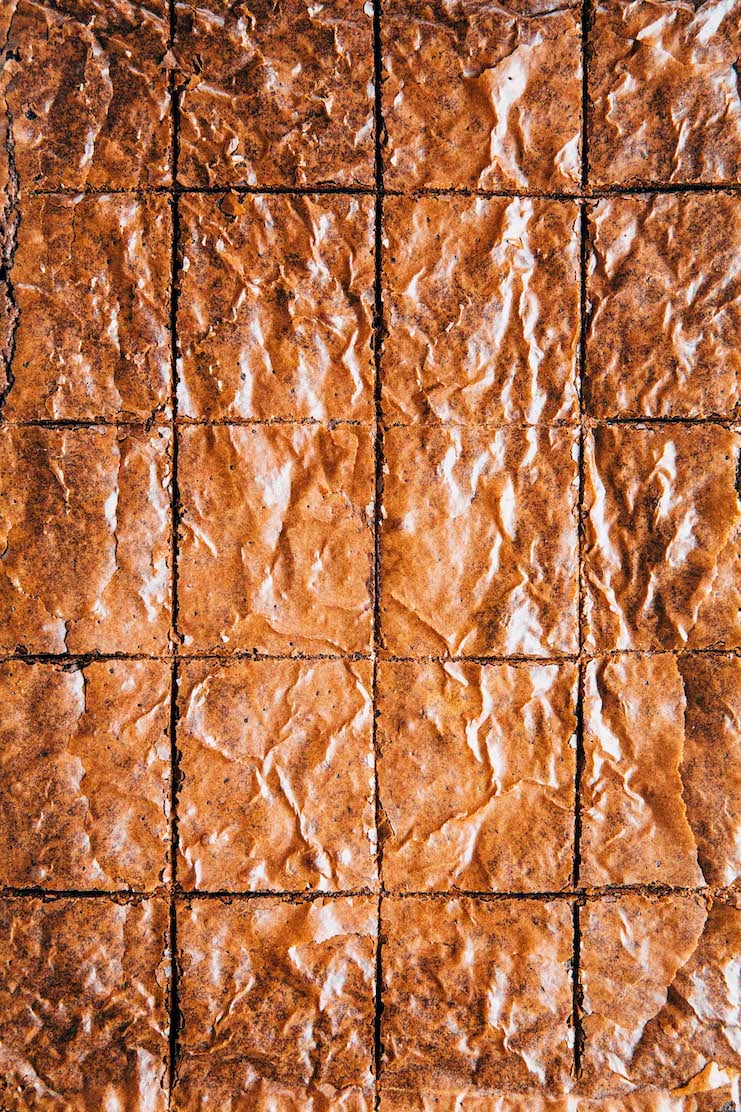
Ingredients and Substitutions
Now that I’ve convinced you to make Sarah Kieffer’s brownies, here’s everything you need for the recipe:
Shopping List for Sarah Kieffer’s Brownies
Be sure to scroll down to the recipe card for the exact ingredient quantities—hit the “Jump to The Recipe” button on the page for a quick shortcut!
- all-purpose flour
- baking powder
- kosher salt
- dark chocolate (between 60% to 70% cacao), from whole fèves or a high-quality chocolate bar (check out this post for my recommendations on baking chocolate!)
- unsalted butter
- Dutch-processed cocoa powder
- large eggs
- granulated sugar
- light OR dark brown sugar
- canola oil
- pure vanilla extract
Natural Unsweetened Cocoa Powder versus Dutch-Processed Cocoa Powder
Cocoa powder, when used in baking recipes, often comes in two varieties: natural unsweetened, and Dutch-processed.
Natural unsweetened cocoa powder is more typical and is cocoa powder in its purest form. It is slightly reddish brown in color and results in deeply flavored chocolate goods. Because it is slightly acidic, it is often paired with baking soda in baking recipes to help create a chemical reaction that will cause the baked good to rise in the oven.
Dutch-processed cocoa powder is natural unsweetened cocoa powder that’s been treated with alkaline to neutralize its acidity, giving it a darker color and milder flavor. It is the cocoa powder that is used for making midnight-black baked goods like Oreos.
I only have natural unsweetened cocoa powder. Can I use that instead?
Yes! You can substitute natural unsweetened cocoa powder for the Dutch-processed cocoa powder in this recipe, no problem. Just a head’s up—your brownies will look and taste just ever-so-slightly different than mine. They will have a more reddish-brown color instead of a blackish-brown one. They’ll also taste a little bit sharper from the acidity of the cocoa powder.
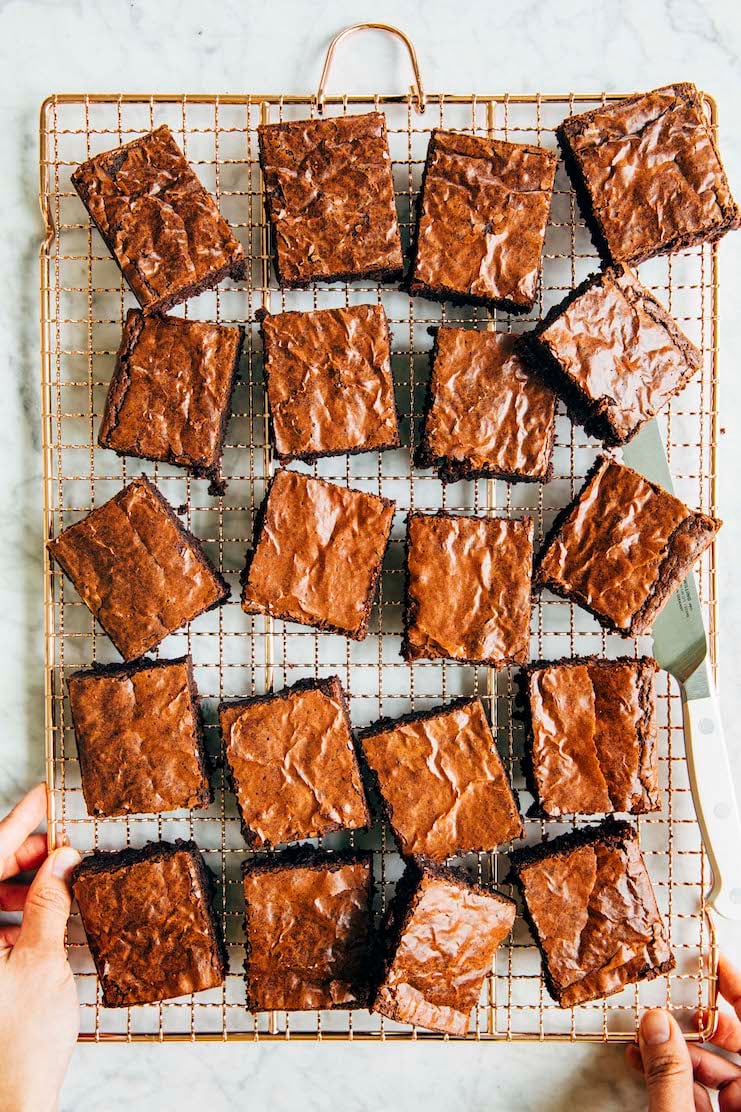
How To Make The Recipe
Here are the basic steps to make Sarah Kieffer’s brownies from scratch:
- Prep the ingredients for the brownies. (Prep Time: 5 to 10 minutes)
It usually takes 5 minutes to prep—that is, measure out all the ingredients needed for the recipe itself—for most of the recipes on Hummingbird High. However, if you’re using chocolate bars to make these brownies, you need to chop up the chocolate. Doing so usually takes around 5 minutes.
To save yourself time, buy thin chocolate bars that are easier to slice. You can also use a food processor to chop the chocolate. But my personal recommendation is to use chocolate discs or fèves for the recipe! You won’t need to chop them before melting. - Start making the brownie batter by melting the chocolate and butter together. (Work Time: 10 minutes)
Combine the chopped chocolate and butter in the top of a double boiler (or a homemade one—see FAQ for more info!). Melt over medium heat until smooth. Whisk in the cocoa powder, then set aside to cool slightly while you work with the rest of the ingredients. - Make the rest of the brownie batter. (Work Time: 5 minutes)
The rest of the recipe goes by in a breeze. Whisk together the eggs, sugars, and vanilla. Add the melted chocolate, whisking to combine. Then, mix in the remaining dry ingredients by hand with a rubber spatula. That’s it! - Assemble the brownies. (Work Time: <5 minutes)
Pour the brownie batter into an 8-inch square pan lined with parchment paper. Spread the batter evenly across the pan with an offset spatula, and smooth its top if necessary. - Bake the brownies. (Bake Time: 25 minutes)
Sarah Kieffer’s brownie recipe bakes for between 30 and 35 minutes. When baking brownies, it’s always better to pull them out of the oven early. Leaving them in too long means that they’ll turn out tough! Check out the recipe and FAQ below for more tips.
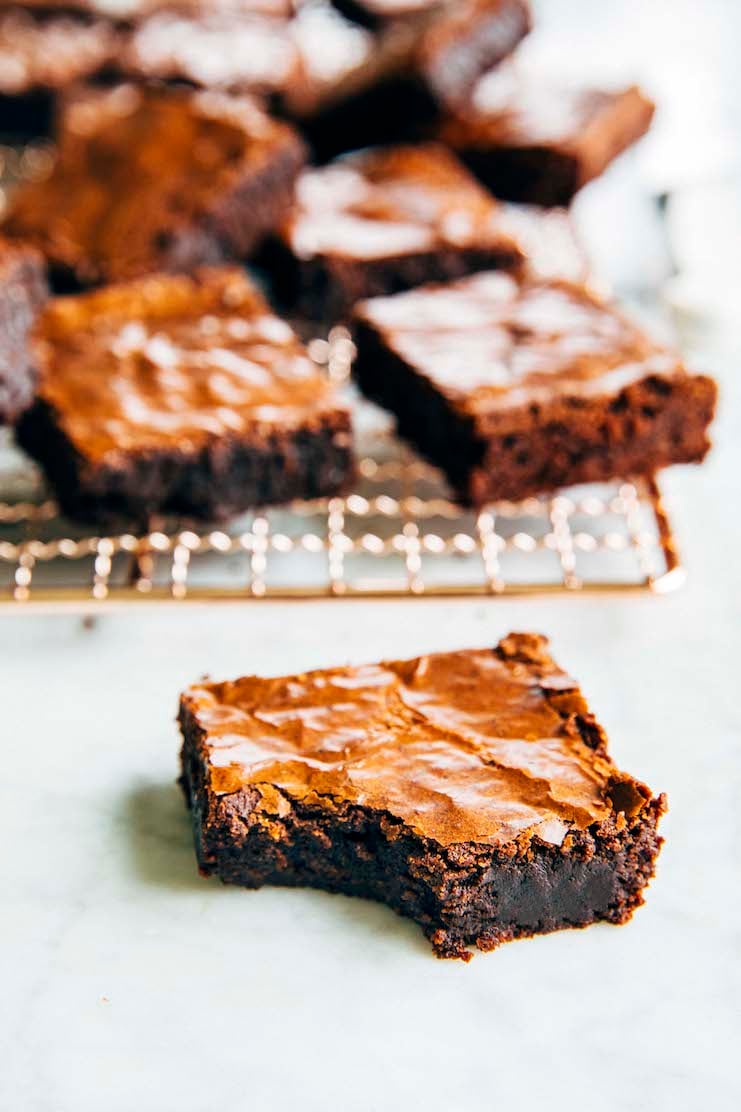
Recipe Troubleshooting and FAQ
Is it better to use a glass or metal pan when baking brownies?
Alright, here we go—when you google the answer to this question, the first few search results will tell you that it is better to use a glass pan when baking brownies. THEY ARE 100% INCORRECT. It is my *FIRM* opinion that it is always, ALWAYS better to use a metal pan when baking brownies.
Why? Glass pans are slow to heat up; however, when hot, they retain heat for much longer. This quality often results in uneven baking. By the time the interior of whatever you’re baking is done, the exterior of it is often overcooked, dry, and overly dark.
What does that mean for these fudgy brownies? If you’re baking the brownies in a glass pan, they’ll continue to bake LONG after being pulled out of the oven because the pan continues to retain so much heat. That usually means dense, dry, and overcooked brownies that are not fudgy at all.
Metal, on the other hand, conducts heat. Because metal heats up faster than glass, it leads to brownies with a better rise (but without being cake) with crispier edges. And because metal pans lose heat quickly after being pulled out of the oven, your brownies will too. That means the brownies will cool faster, and they won’t be overdone. Instead, they will instead be perfectly fudgy and set. So please use a metal pan for this recipe!
Finally, if you want to be a perfectionist, choose a light colored metal pan over a dark metal pan. Dark pans absorb more heat, which, like glass, can cause the exterior of the brownies to bake too quickly. I always use pans from Williams-Sonoma’s Goldtouch Pro Nonstick line for my baking.
Help! My brownies don’t have the shiny paper crinkle top like yours do. What did I do wrong?
It’s likely that you either:
a) used too much flour
b) used too little sugar
c) baked the brownies for too long and/or used the wrong type of pan to make them.
First, let’s talk about measuring ingredients. A lot of people don’t have the right technique when using measuring cups. It’s easy to use too much flour when using volume measures. Don’t use the measuring cup to scoop the flour in the bag and pack it down into the cup. Instead, set the measuring cup on the counter and then spoon the dry ingredients into it. Once it’s formed a small mound, don’t pack it down. Use a butter knife or bench scraper to level it off.
While this technique works best for ingredients like flour, you’ll need to do the exact opposite for measuring brown sugar. Spoon the brown sugar into the measuring cup. Once it’s formed a small mound, pack it down, then add more brown sugar until it is level with the top of the measuring cup.
Finally, if you used the techniques above OR used weight measures (which I always recommend, since you won’t need to fuss with the techniques I just outlined) and are STILL experiencing issues, it’s likely that the brownies were overbaked. Check out the FAQ above on why you should always use a metal pan when baking brownies, as well as the baker’s notes below on how to test brownies for doneness.
Can you freeze this brownie recipe?
Yes! You can freeze the baked brownies.
To freeze the brownies, individually wrap any leftover bars in two layers of plastic wrap, then a layer of aluminum foil. The aluminum foil will prevent the bars from absorbing any other flavors or odors in the freezer. Freeze for up to 3 months.
When ready to serve, transfer to the refrigerator to thaw overnight. You can eat the brownies straight from the fridge, or rewarmed in the microwave.
Best Brownie Recipe Tips
Ingredient Tip
- The brownie batter recipe states that you need 8 ounces (227 grams) of chopped dark chocolate to make the brownie batter. If you don’t have a digital kitchen scale, that’s equivalent to 1 ⅓ cup of chopped chocolate. Each piece of chocolate should be roughly the same size and shape of a regular-sized chocolate chip.
Baking Tip
- It’s better to pull the brownies out of the oven early than leave them in too long—if you over bake the brownies, they’ll be tough. They might appear underbaked, but I promise that when they’ve cooled, they will be perfect.
Get the Recipe: Sarah Kieffer’s Brownie Recipe
Ingredients
- 1 cup plus 2 Tablespoons (5.65 ounces or 160 grams) all-purpose flour
- ½ teaspoon baking powder
- ¾ teaspoon kosher salt
- 8 ounces (227 grams) dark chocolate (between 63% and 73% cocoa), from whole fèves or a high-quality chocolate bar, chopped into ½- to 1-inch pieces
- ½ cup (1 stick or 4 ounces or 113 grams) unsalted butter, chopped into 1- to 2-inch pieces
- ¼ cup (0.90 ounces or 25 grams) Dutch-processed cocoa powder, sifted if lumpy
- 4 large eggs
- 1 ½ cups (10.5 ounces or 300 grams) granulated sugar
- ½ cup tightly packed (3.75 ounces or 106 grams) light or dark brown sugar
- ½ cup (4 ounces or 113 grams) canola oil
- 2 teaspoons pure vanilla extract
Instructions
- Prep your oven and pan. Position a rack in the center of the oven and preheat the oven to 350°F. Lightly spray a 9 x 13-inch cake pan with cooking spray and line with parchment paper, leaving a 2-inch overhang on the pan’s two long sides. Spray the parchment, too.
- Mix the dry ingredients. In a medium bowl, whisk together the flour, baking powder, and salt.
- Melt the chocolate and butter, then add the cocoa powder. Place the chocolate and butter in the top pan of a double boiler or in a heatproof bowl set over a medium, heavy-bottomed saucepan filled with a few inches of simmering water (be sure the bottom of the bowl does not touch the water).Cook over medium heat, using a heatproof rubber spatula to stir the mixture and scrape the sides of the bowl occasionally, until the chocolate and butter have melted and combined, about 5 minutes. Remove the pan or bowl from heat, set on a wire rack, and stir in the cocoa powder.Let the chocolate mixture cool slightly while you prep the other ingredients.
- Whisk the eggs, sugars, oil, and vanilla, then add the chocolate mixture and the flour and salt. In a medium bowl, whisk together the eggs, sugars, oil, and vanilla.Slowly pour in the chocolate mixture while whisking. Sprinkle the dry ingredients over the batter all at once and use a rubber spatula to mix until just combined.
- Assemble the brownies. Pour the batter into the prepared pan and use an offset spatula to smooth the top.
- Bake the brownies. Bake for 30 to 35 minutes, or until a skewer inserted into the center of the brownies comes out with a few crumbs attached. Cool completely on a wire rack before slicing.
- Serve and store. Run a butter knife or offset spatula along the edges of the pan and use the overhanging parchment as handles to lift the brownies out of the pan and onto a cutting board. Slice into 20 rectangles, each about 2 ¼ inches wide and 2 ½ inches long, and serve. The brownies can be stored in an airtight container or zip-top bag at room temperature for up to 3 days.
Notes
- Adapted from Sarah Kieffer’s 100 Cookies and The Vanilla Bean Baking Book
Did you make this recipe?
Please leave a comment and rating for the recipe using the form below!
Your ratings make it easier to find the recipe online, and I’m always looking for ways to improve Hummingbird High.

